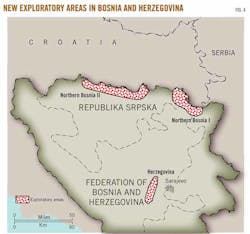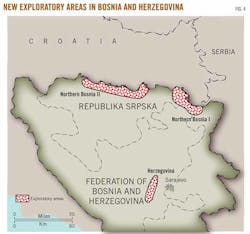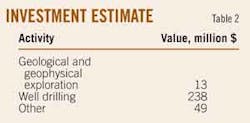Exploration, production pace faster in Serbia, Bosnia and Herzegovina
View Article as Single page
New exploration in Bosnia and Herzegovina
In Bosnia and Herzegovina oil and gas exploration has been carried out for more than a 100 years, but commercial accumulations haven't been found.
In this region several domestic and foreign companies (INA, Energoinvest, Amoco, ECL, GECO, EXLOG, and others) were involved in petroleum exploration that can be grouped into several periods:
(1889-1915)—three wells were drilled to 130-140 m and registered the first traces of oil.
(1929-41)—44 wells were drilled to 50-2,025 m, and a small oil reservoir was discovered that produced about 1,000 tons through six wells.
(1948-61)—45 wells were drilled to 250-1,750 m in the Tuzla basin, Posavina, and Semberija with registered oil occurrence.
(1963-73)—four deep wells were drilled in northern Bosnia inner and outer Dinarides and registered oil occurrence.
(1973-92)—extensive geochemical, geomagnetic, geophysical, seismic, and magnetotelluric surveys in the projects named "Northern Bosnia" and "Dinarides" have confirmed the presence of petroleum.
The Northern Bosnia project involved the exploration of Bosnia's northern area which includes southern parts of the Pannonian Tertiary basin, i.e., inner Dinarides Mountains. The north border is the Sava River, and the western and eastern borders are the Una and Drina rivers, respectively.
The Dinarides Project, carried out by Amoco in 1989-92 with a $12 million investment, covered the central and outer Dinarides Mountains, i.e., the terrain of central Bosnia (Sarajevo-Zenica basin), and Herzegovina. The project defined prospective structures close to Trebinje, Stolac, Nevesinje, Mostar, and a "megastructure," Dreznica.
The results indicate oil and gas potential in the northern region at 2,000-4,000 m and in the south part of Bosnia (Dinarides area) at 4,000-6,000 m.14
At the present stage of exploration of northeastern Bosnia, the oil resource estimates15 for four prospective sites are:
1. The area south from Samac (22 sq km), about 67.2 million bbl.
2. The area southwest from Orasje (37 sq km), 44.5-113.2 million bbl.
3. The Tinje River valley in the Tuzla region (25 sq km), 104.4 million bbl.
4. The area of Lopar (21 sq km), 86.9 million bbl.
In 2011, the Jadran-Naftagas joint venture has continued oil and gas exploration in Bosnia and Herzegovina within the territory of the Serb Republic. Its program includes geological exploration, 2D and 3D seismic surveys, and drilling 17 exploratory wells. The petroleum-geological exploration concept is similar to the program that NIS-GazpromNeft conducted in central Serbia last year.
New exploration in this region is focused on three perspective sites: northern Bosnia I, northern Bosnia II, and eastern Herzegovina (Table 1 and Fig. 4).
The estimate of recoverable resources in this region is 73-87 million boe. The investments in geological exploration program 2011-13 will be $9.2-17.6 million with a maximum variant of $300 million of investments (Table 2). The dynamic production plan stipulates the beginning of petroleum exploitation in 2014.15



